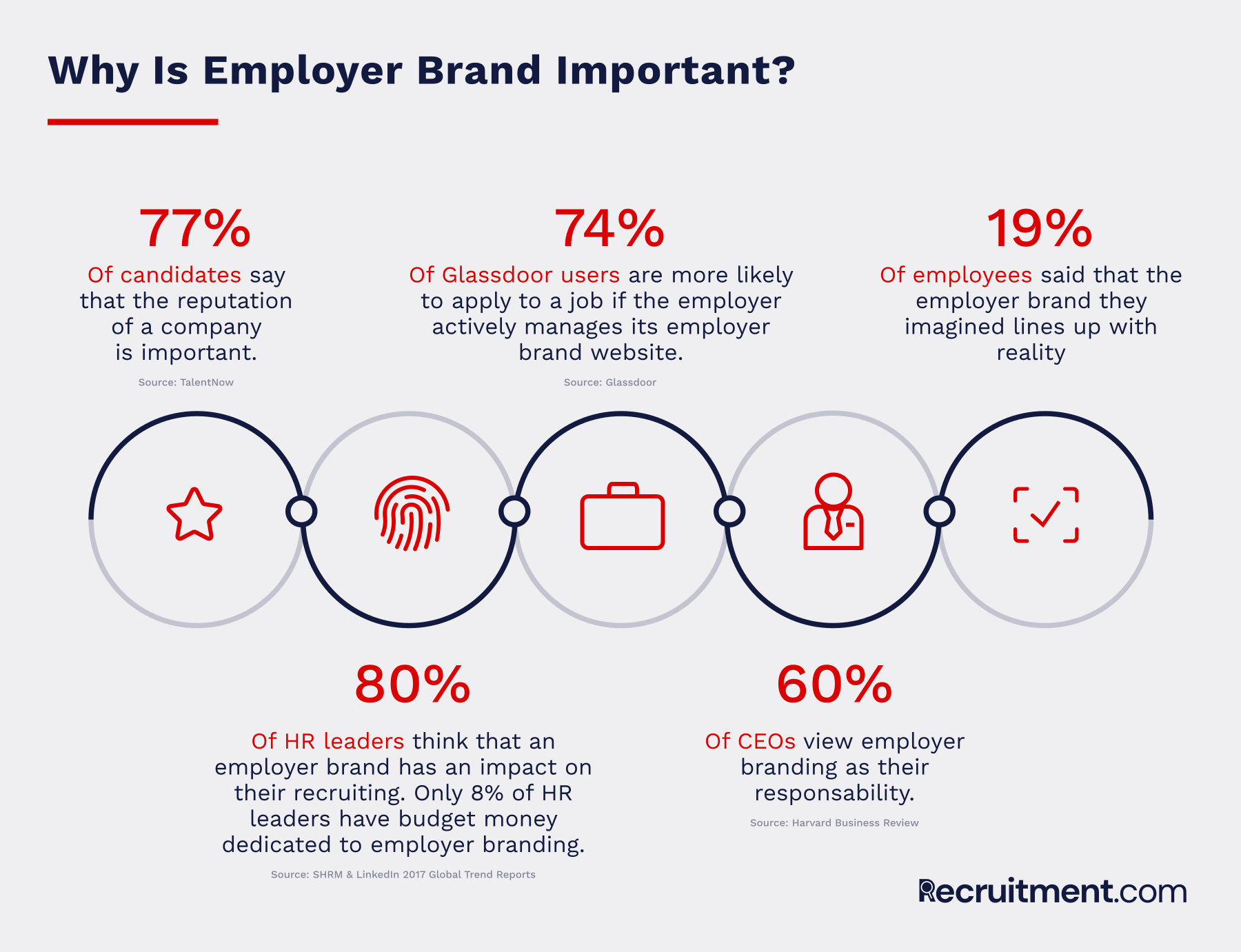The Essentials of Employer Branding

Josh Spilker is a writer and editor with more than 15 years of experience covering technology, recruiting, and the future of work.
Employer branding is how you market to the talent communities, recruits and recruiting agencies that are recommending future employees. It focuses on the people who want to join you, going beyond the typical consumer.
What do people think about working at your company? What impression do they have?
What would employees and your top talent list as the pros and cons? The good and bad?
Their responses are a key metric of your employer brand. Those reactions, thoughts, and questions from employees, candidates, and applicants are a gauge of your company’s reputation in the marketplace. This is one indicator of how well your brand will do in acquiring talent.
Is an employer brand the same as company marketing?
At first glance, it seems that an employer brand would be the same as company marketing. But it’s vastly different.
The employer brand is the concern of the marketing department, but also product, sales, and the warehouse and everything in between.
But it’s very different. Traditional marketing is trying to get consumers or other companies to do business with you. It’s about what you’re selling.
Then...what is an employer brand?
Employer branding, on the other hand, is what candidates think about working at your company. It’s your reputation in the marketplace.
That’s why companies tout their inclusion in lists such as “The Best Places To Work.” A list like that is a stamp of approval that the culture, workplace, and environment are good. It also signals to candidates that this would be a good employer, especially when their current employer does not make it.
The consulting firm Deloitte defines employer branding like this:
An employer brand...seeks to encapsulate the total value that employees gain from their relationship with an employer. By articulating and promoting an employer brand, a company can communicate the value of an integrated portfolio of benefits, helping employees appreciate the full scope of what the employer offers and enhancing the attractiveness of the employee-employer relationship.
The benefits of a strong employer brand may be obvious, and you may even be convinced of its value.
But is that making a real difference in your company? Most HR teams do believe in the power of an employer brand but they may not be doing much about it.
80% of HR leaders think that an employer brand has an impact on their recruiting and 75 percent of applicants report being concerned about an employer’s brand before submitting an application.
When you have a solid employee value proposition--how job candidates perceive the value of working for your company--then your retention and job satisfaction is high, which then impacts your company's reputation.
HR leaders are concerned about a strong employer brand and applicants are too. So as an HR function, are you putting your money where your mouth is?
That isn’t always the case, at least from a budget perspective. Recent research from LinkedIn says that even though HR leaders say employer branding is imperative, only eight percent of them have budget money dedicated to it.
It may be time then to increase your resources dedicated to maintaining a positive employer brand to help expand your footprint for talent acquisition.
What Are The Important Parts Of An Employer Brand?

An employer brand is a combination of the company’s reputation and the values that you offer potential employees, such as the culture, projects, advancement opportunities, and more. Your employer brand is greatly influenced by current employees, referrals, word of mouth, and any existing vendor relationships that you may have. All of them report and talk about your brand in one form or another.
A positive employer brand will boost recruiting, employee engagement and retention.
When shaping your employer brand strategy, consider how each of these elements impacts your employer brand.
1. Company culture.
Company culture can be intentional or by default. It happens either way. Your company will fall into a culture or intentionally develop one. Proactive company culture helps stop problems before they begin. Company culture is too important to leave up to chance. Your company adopts a certain personality and method even if you don’t intend for it too.
Culture is action-oriented, rather than policy-driven, emphasizing attitudes and actions instead of what’s cited on a slide deck.
“Culture is learned behavior — it’s not a by-product of operations. It’s not an overlay,” writes Jim Whitehurst, the CEO of Red Hat. “We create our organizational culture by the actions we take; not the other way around.”
Company culture is an organic force that seeps its way into the public sphere through your employees, their interactions and the publicity you do. Company culture is what is on your agenda, what you are focused on and even informs your business decisions.
2. Company reputation.
This is how employees discuss your company, your workplace, and the working environment. Word of mouth, review boards and community forum discussions can impact how your company is perceived by the best talent.
However, there is often a disconnect between what candidates expect and what happens once they arrive. A study by Weber Shandwick showed that only 19% of employees said that the employer brand they imagined lines up with reality.
By strongly aligning the employer brand with expectations, Weber Shandwick found that retention, recruitment, and productivity increased. In their research, they found that an employer reputation impacts 49% of an employee's decision to stay. It’s worth the effort to make your brand meaningful to employees and recruits.
3. Personalized outreach.
With a strong employer brand, you can reach directly out to candidates and get a better response rate. Personalized outreach to passive candidates is endearing and a solid employer reputation and brand will make them more likely to respond. This direct sourcing makes candidates feel wanted and when supported by a strong employer brand, makes them more likely to consider your company. At Yahoo, one recruiter experienced a response rate of almost 70% once she began customizing her outreach emails more deliberately.
With personalized outreach, a stronger bond is created between the recruiter and the candidate. This may mean researching the candidate’s social media for appropriate references or mention any connections or work they did at previous employers.
4. Innovation.
Former Netflix HR exec Patty McCord says that “good talent managers think like business people and innovators first and like HR people last.” But in order for that to happen at the HR level, it happens within your company first. Many times, HR is the first introduction to your company. Is your HR department innovative and disruptive? Is it responsive and decisive? These choices trickle down to the types of people that are attracted to your brand. Employees are searching for reasons to remain with a company. Innovation is the hidden “wow” factor that makes employees proud to be among your company’s ranks.

How To Improve Your Employer Brand
1. Properly maintain your social media
Companies used to take out ads or magazine spreads to discuss their company reputation. Yes, many still do send a press release with notable accomplishments, but this is meant for journalists and the media, not necessarily for potential employees.
Social media has replaced a lot of that and has become the number one go-to source for potential employees checking out the culture of your brand.
One thing they’re looking for? Personality. This doesn’t mean your brand has to be outgoing or to be different than your culture. But it should be representative of what your culture is really like. So if it is fun and different: make it that way. If it’s strait-laced, that’s okay too. Your social media shouldn’t give a false sense of who your company really is.
2. Employee advocacy
Instagram and social media gave rise to influencer marketing. And that’s what employee advocacy is for your brand to potential recruits. Employee advocacy is how your employees talk about your brand with others. It’s influencer marketing for recruiting.
Your employees have ideas and opinions, and part of this is putting a face with their ideas and successes. Did your product manager think of a great feature idea? Create a social media story or blog post around it. Let them speak at the all-company meeting. Potential employees want to know that their voice will count when they make a move. And employee advocacy is the way to show that.
If your candidates are only a perspective from HR and recruiting, then they are missing out on the real experiences they’ll have at your company. Employee advocacy stories bridge that gap.
Leadership expert and business author Daniel Pink says that we’re all in sales now.
Employee advocacy is how your employees participate in.
What if employees go off message?
That’s a huge concern. However...the trick with employee advocacy is that you must be okay with that. You can provide guidelines and talking points, but ultimately, your employees will express themselves. This does not mean that you shouldn’t be selective about the employees you invite into your employee advocacy program, just be aware that mistakes will be made. You can’t demand perfection. Potential employees are watching to see how you respond. ARe you sympathetic to their requests or always defensive?
74% of Glassdoor users are more likely to apply to a job if the employer actively manages its employer brand on the site.
This fact includes the positive and negative. Potential employees want to see your responses to adversity and employee concerns. Glassdoor and LinkedIn provide an insight into that. Think carefully about your actions on these sites--because recruits are watching.

3. Incorporate executive strategy
Companies now view the employer brand as part of the CEO’s role, beyond human resources and marketing. A report from Universum found that 60% of CEOs view employer branding as their responsibility.
Employer branding has reached critical mass at the executive level. If it’s on their radar, you need to be more aware of it, but view it as an opportunity--not as something to be afraid of. Leverage that access and interest. Think about interviews, videos and interactions with new employees to enforce your culture and ideas. If CEOs believe they can help and are responsible for the employer brand, then take advantage of it.
What does a great employer brand look like?
Now that we have examined all of the key factors of what makes for an exciting employer brand, let’s take a look at a company who is doing it exceptionally well.
L’Oreal, the makeup and hair care brand, has an amazing employer brand. Once you take a look at their assets, you really start to understand the difference between marketing and employer branding.
What has made L’Oreal stand out?
Dedicated LinkedIn campaign. Once they reached 300,000 LinkedIn followers, they launched a specific campaign to connect their followers with open positions. The “In” campaign displayed their company values and how they related to open positions, inviting followers to explore and take part.
Recruiting on YouTube. Separate from its core brand, L’Oreal also has a YouTube channel solely focused on recruiting and working at the company. It shows how the company brainstorms, life with their interns and how to craft your resume to stand out for their recruiting team.
Content and blogging. They also provide a blog solely dedicated to life and careers at L’Oreal, including profiles, news and experiences from employees. This story from an employee who admitted he had never been to a hair salon or had much interest in beauty shows is a perfect example of employee advocacy.
Conclusion: An Employer Brand Is Bigger Than Individual Parts
Why maintain your employer brand? It’s what job applicants are interested in. Research says that 84% of candidates say that the reputation of a company is important. How you enrich your employer brand will impact your recruiting.
An employer brand is more than the sum of its parts. It is the first impression that you want everyone to have when they think of working for your company. You are aiming for a genuine and trustworthy expression of your brand. To make it stick, you need buy-in from each level: from individual recruiters, from your HR department, from employees in all departments and your executive team.
- How is your employer brand?
- What other insights would you add?

Josh Spilker is a writer and editor with more than 15 years of experience covering technology, recruiting, and the future of work.






